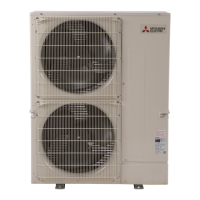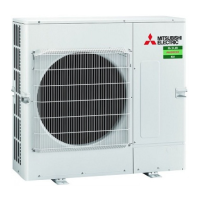
Do you have a question about the Mitsubishi Electric PUZ-A30NHA4 and is the answer not in the manual?
| Brand | Mitsubishi Electric |
|---|---|
| Model | PUZ-A30NHA4 |
| Category | Air Conditioner |
| Language | English |
Lists various indoor unit models and their associated service and manual numbers.
Basic safety rules before accessing electrical terminals, emphasizing circuit disconnection.
Specific safety guidelines for using R410A refrigerant, including pipe and tool requirements.
Lists essential service tools for R410A refrigerant operations and their specifications.
Details precautions for R410A piping work, including pipe thickness and flare nut dimensions.
Pre-charged refrigerant system for simplified installation, reducing additional charging work.
Table detailing refrigerant charge amounts for models based on piping length.
Technical specifications for the compressor, including winding resistance.
Octave band sound pressure level curves for different models during cooling and heating.
Standard operational data for heat pump models, covering electrical, refrigerant, and environmental parameters.
Standard operational data for cooling-only models, covering electrical, refrigerant, and environmental parameters.
Specifies minimum clearances required around the outdoor unit for proper installation and ventilation.
Details on foundation bolts and piping/wiring directions.
Legend for wiring symbols and model selection via DIP switches.
Details M-NET adapter connections and communication wiring.
Wiring specifications for indoor units powered by outdoor units using A-control.
Outlines wiring specifications for units with separate indoor and outdoor power supplies.
Specifies cable types and lengths for connecting indoor and outdoor units.
Explains the correct method for wiring M-NET communication, including grounding.
Procedures for setting M-NET and refrigerant addresses for system control.
Provides a step-by-step procedure for recovering refrigerant from the system.
Details how to start and finish a test run for system verification.
Summarizes error codes and lists essential pre-test run checks.
How to perform self-diagnosis and interpret results.
Steps for diagnosing issues with the remote controller itself.
Malfunction diagnosis method using a wireless remote controller.
Table for diagnosing and taking action on power-on abnormalities.
Offers solutions for common operational issues and symptoms not covered by error codes.
Methods to check resistance of various components like thermistors and motors.
Procedure for emergency operation during specific error conditions.
Visual guide to test points on circuit boards for troubleshooting.
Explains the functions of DIP switches, connectors, and jumpers.
Details low-level sound priority and demand control functions.
Explains LED indicators and abnormal condition displays.
How to enter and use maintenance mode for checking operation data.
Guidance for checking operation conditions using graphs and tables.
How to set unit functions using the wired remote controller.
How to select functions using the wireless remote controller.
Procedure to switch temperature display between °C and °F.
Steps to access and monitor operational data via the remote controller.
List of request codes for retrieving operation data.
Instructions for removing the top, service, front, and back panels.
Step-by-step guide to removing the fan motor assembly.
Procedure for safely removing the electrical parts box.
Procedures for removing various thermistors.
Instructions for removing valve and expansion valve coils.
Step-by-step guide to removing the 4-way valve.
Instructions for removing the linear expansion valve.
Procedure for removing the high and low pressure switches.
Steps to remove the reactor and capacitor.
Detailed steps for removing the compressor.
Instructions for removing the accumulator.












